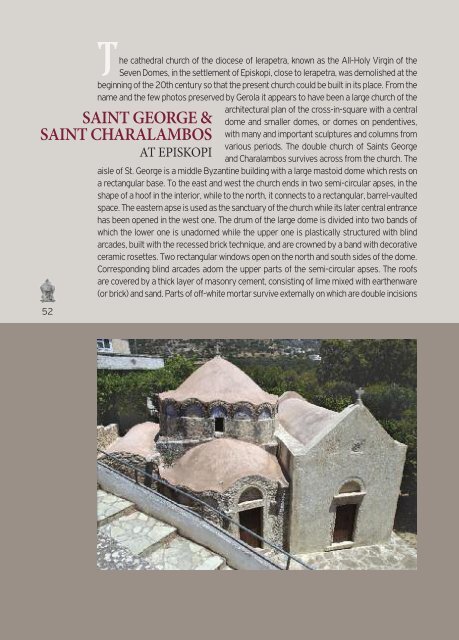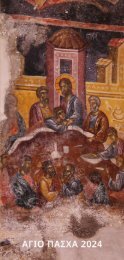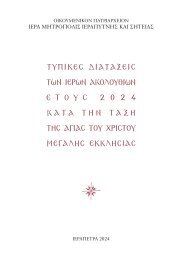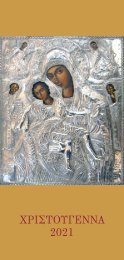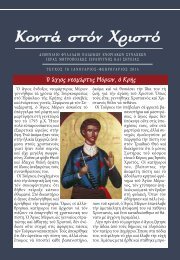Create successful ePaper yourself
Turn your PDF publications into a flip-book with our unique Google optimized e-Paper software.
he cathedral church of the diocese of Ierapetra, known as the All-Holy Virgin of the<br />
Seven Domes, in the settlement of Episkopi, close to Ierapetra, was demolished at the<br />
beginning of the 20th century so that the present church could be built in its place. From the<br />
name and the few photos preserved by Gerola it appears to have been a large church of the<br />
SAINT GEORGE &<br />
SAINT CHARALAMBOS<br />
AT EPISKOPI<br />
52<br />
architectural plan of the cross-in-square with a central<br />
dome and smaller domes, or domes on pendentives,<br />
with many and important sculptures and columns from<br />
various periods. The double church of Saints George<br />
and Charalambos survives across from the church. The<br />
aisle of St. George is a middle Byzantine building with a large mastoid dome which rests on<br />
a rectangular base. To the east and west the church ends in two semi-circular apses, in the<br />
shape of a hoof in the interior, while to the north, it connects to a rectangular, barrel-vaulted<br />
space. The eastern apse is used as the sanctuary of the church while its later central entrance<br />
has been opened in the west one. The drum of the large dome is divided into two bands of<br />
which the lower one is unadorned while the upper one is plastically structured with blind<br />
arcades, built with the recessed brick technique, and are crowned by a band with decorative<br />
ceramic rosettes. Two rectangular windows open on the north and south sides of the dome.<br />
Corresponding blind arcades adorn the upper parts of the semi-circular apses. The roofs<br />
are covered by a thick layer of masonry cement, consisting of lime mixed with earthenware<br />
(or brick) and sand. Parts of off-white mortar survive externally on which are double incisions<br />
in imitation of opus isodomum masonry. These elements contribute to the dating of the<br />
monument to the 11th century. The barrel-vaulted, single-nave church of St. Charalambos<br />
was added on the south side, during the 16th century. The narrow fronts end in triangular<br />
pediments that form parapets and the roof is covered by a thick layer of masonry cement<br />
consisting of lime mixed with earthenware/brick and sand, as is customary generally in<br />
eastern Crete.<br />
From excavation research which took place in the interior of the church and underneath the<br />
more recent floors and graves, constructions and plumbing were discovered incorporated in<br />
the masonry which show that the church was originally a middle Byzantine bath which was<br />
transformed into a church in the years of the late Venetian occupation, with the demolition<br />
of the south compartment and the erection, in its place, of a second aisle, the opening of the<br />
west door and other modifications so that it could respond to its new use. It seems that,<br />
originally, the north section played the role of the “frigidarium, cold,” the central the role of<br />
the “caldarium, hot” and the south one the role of the “tepidarium, lukewarm.” It presents<br />
close typological similarity with other middle Byzantine baths, such as in the Monastery of<br />
Kaisariani and the Zoodochos Pigi [Life-giving Spring] at Dervenosali. It obviously predates<br />
the smaller, similarly formed, bath of Kato [Lower] Episkopi in Siteia which was also converted<br />
into the church of the Holy Apostles in the same period. The bath of Episkopi at Ierapetra<br />
appears to be directly connected with the Episcopal complex which probably existed close<br />
to the demolished cathedral church of the All-Holy Virgin of the Seven Domes. [M. A.]<br />
53<br />
The large number of churches within and without the settlement of Kavousi is evidence<br />
of its flourishing, mainly during the period of Venetian occupation.<br />
St. George, in the centre of the settlement, belongs to the architectural plan of the singlenave<br />
church with a transverse, tripartite narthex. It has two layers of wall painting decoration<br />
of the 14th and 15th centuries, of which the later one is the most<br />
extensively preserved in the main church and the central section of<br />
the narthex. The iconographic programme includes, apart from the<br />
usual Christological cycle, a compact Marian cycle and the cycle of<br />
St. George. The west wall and parts of the lateral walls are occupied by the large representation<br />
of the Second Coming with its miniature and particularly graphic figures of the damned in its<br />
lower part. From the remaining representations, Abba Zosimas with St. Mary of Egypt in the<br />
intrados of the north arch of the narthex as well as the western-style depiction of the All-<br />
Holy Virgin the Galaktotrofousa [Milk-giver] on the north wall close to the altar screen, are<br />
noteworthy.<br />
The single-nave church of the Holy Apostles, 100 metres to the south of St. George, also<br />
has two layers of wall paintings of the 14th and 15th centuries respectively. From the first<br />
layer very few forms can be discerned, such as the full-length figure of the woman donor on<br />
the north wall who has the attributive “presvyterysa” [wife of a priest]. The second layer,<br />
THE CHURCHES<br />
AT KAVOUSI


